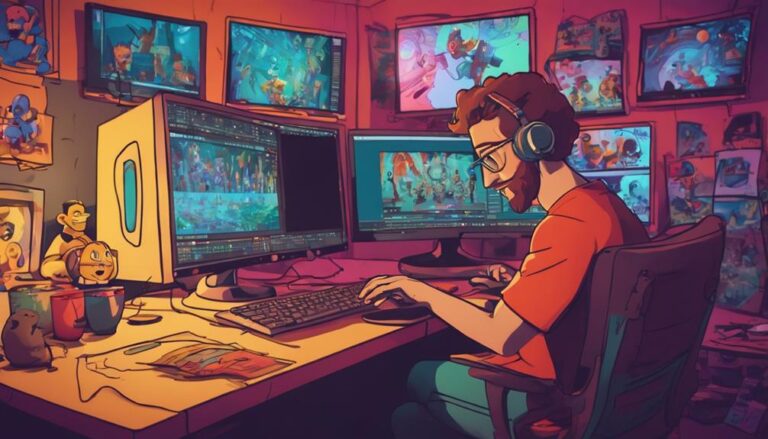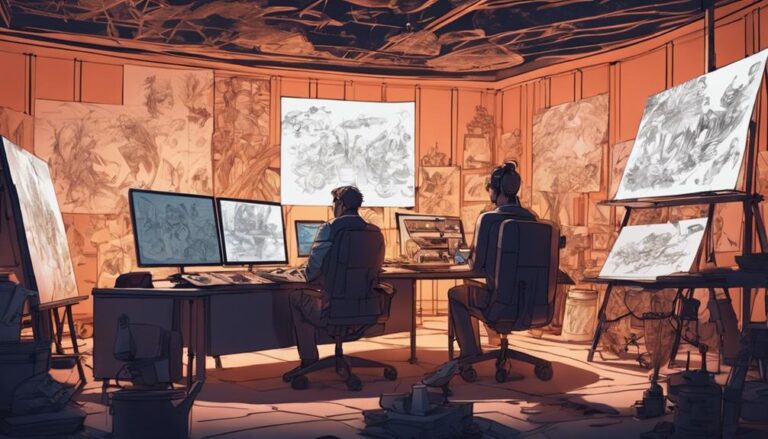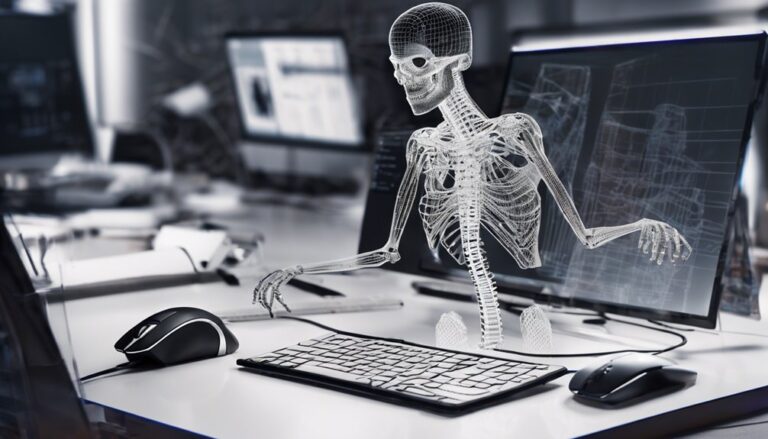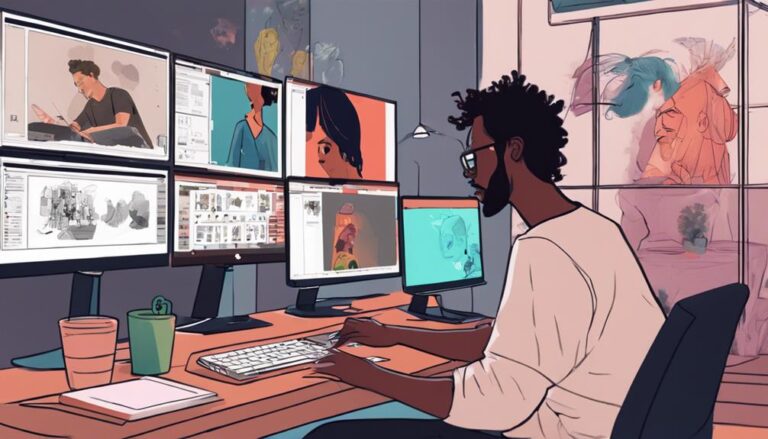What Is Traditional Animation for Corporate Videos?
You're likely familiar with traditional animation as a nostalgic staple of childhood cartoons, but its applications go far beyond Saturday morning TV. Traditional animation involves creating each frame by hand, allowing for a hands-on approach to experiment with unique techniques and styles, introducing subtle imperfections and organic textures that evoke a more relatable feel. In corporate videos, traditional animation enables you to convey complex information in an engaging and memorable way, presents data in a visually appealing format, and creates emotional resonance with your audience. And that's just the beginning of what it can bring to the table.
Key Takeaways
- Traditional animation for corporate videos conveys complex information in an engaging and memorable way.
- It enables creative freedom to experiment with different visuals, colors, and characters.
- Traditional animation creates emotional resonance with the audience and leaves a lasting impression.
- It involves various techniques, including cell animation, stop-motion, and whiteboard explainers.
- Corporate videos use traditional animation for brand storytelling, explainer videos, and showcasing company culture and visual identity.
Benefits of Traditional Animation
One of the most significant benefits of traditional animation in corporate videos is its ability to convey complex information in an engaging and memorable way.
When you use traditional animation, you're able to present data, statistics, or ideas in a visually appealing format that captures your audience's attention and retains their interest. This style of animation allows for creative freedom, enabling you to experiment with different visuals, colors, and characters to effectively communicate your message.
Traditional animation also enables you to create emotional resonance with your audience.
By using hand-drawn or hand-crafted elements, you can add a personal touch to your video, making it more relatable and engaging. This style of animation can evoke emotions, convey empathy, and build connections with your viewers.
As a result, your corporate video is more likely to leave a lasting impression and achieve its intended purpose, whether it's to educate, persuade, or entertain. By leveraging traditional animation's unique strengths, you can create a corporate video that truly stands out.
History of Traditional Animation
From the earliest hand-drawn cartoons of Émile Cohl to the modern-day masterpieces of Disney, traditional animation has undergone significant transformations over the years, shaping the industry into what it's today.
You'll discover that early innovators like Winsor McCay, who created the influential short film "Gertie the Dinosaur" in 1914, paved the way for future animators.
McCay's use of registration marks and keyframe animation techniques set the standard for the industry.
As you delve deeper into the history of traditional animation, you'll encounter forgotten pioneers like James Stuart Blackton, who experimented with stop-motion techniques in the early 1900s.
These pioneers played a crucial role in laying the groundwork for the art form, often working tirelessly behind the scenes.
Their contributions may have been overlooked, but their influence can still be seen in modern animation techniques.
The evolution of traditional animation has been marked by innovation, experimentation, and perseverance.
Types of Traditional Animation
Traditional animation encompasses various techniques, each requiring distinct skill sets and artistic approaches.
As you explore the world of traditional animation, you'll encounter methods that cater to different styles, budgets, and goals.
One prominent technique is Cell Animation, also known as Hand-Drawn Animation.
This labor-intensive process involves drawing each frame by hand on transparent celluloid sheets, then layering them over static backgrounds to create the illusion of movement.
Another technique is Stop Motion, which involves manipulating physical objects or puppets, capturing a frame, and then making slight adjustments to create the next frame.
This process is repeated, resulting in a fluid motion when the frames are played in sequence.
Stop Motion can be further divided into sub-techniques, such as replacement animation, where multiple versions of a character or object are created to achieve specific movements.
Both Cell Animation and Stop Motion require patience, attention to detail, and a deep understanding of animation principles.
Process of Creating Animation
To create a traditional animation for your corporate video, you'll start by developing a script and storyboard that outline the narrative and visual elements.
Next, you'll draw key frames, which are the most important frames in a scene that define the action and movement.
Script and Storyboard
Developing a solid script and storyboard is a crucial step in the traditional animation process for corporate videos.
You'll start by creating a script that clearly communicates your message and engages your audience. This involves script development, where you'll craft a compelling narrative, define your characters, and plan your pacing.
A well-written script will serve as the foundation for your entire animation.
Once you have a solid script, you'll move on to visual planning.
This is where you'll create a storyboard, a series of sketches that outline the sequence of events in your animation.
Your storyboard will help you visualize the flow of your animation, plan your camera angles, and make any necessary changes before you start drawing.
A good storyboard will ensure that your animation is well-paced, engaging, and effectively communicates your message.
Drawing Key Frames
The blueprint for your corporate animation is finally taking shape, as you shift your focus to drawing key frames – the pivotal images that define the most critical moments in your narrative.
These key frames serve as the foundation for your entire animation, dictating the pacing, tone, and overall flow of your video.
When drawing key frames, consider the frame rates you want to achieve. Typically, traditional animation operates at 24 frames per second (fps), but you may choose to work with a higher or lower frame rate depending on your specific needs.
Ensure that your key frames are spaced accordingly to create a smooth, cohesive motion.
It's also essential to consider motion capture when drawing key frames. While traditional animation involves hand-drawn images, motion capture technology can be used to record and translate real-world movements into digital data.
This can be especially useful for complex character interactions or dynamic action sequences. As you draw your key frames, keep in mind how motion capture might be integrated into your animation to enhance its overall realism and impact.
Final Editing Phase
As you near the completion of your corporate animation, refining your key frames and motion capture elements, it's now time to transition into the final editing phase.
This critical stage requires attention to detail and a clear understanding of your editing workflow.
With your animation assets in place, you'll import them into your chosen editing software, such as Final Cut Pro.
In the final editing phase, you'll focus on assembling the individual elements into a cohesive narrative.
This involves:
- Sequencing scenes: Arrange your key frames and motion capture elements in a logical order, ensuring a smooth flow of animation.
- Adding visual effects: Incorporate special effects, such as transitions, text overlays, or 3D models, to enhance the visual appeal of your animation.
- Sound design and mixing: Balance the audio levels, add music or sound effects, and fine-tune the overall audio experience to complement your visual elements.
Examples of Corporate Animation
When creating corporate videos, you'll likely use traditional animation in various formats to convey your message.
You may employ explainer video styles, such as 2D animated tutorials or kinetic typography, to break down complex information into engaging visuals.
Additionally, you can utilize brand storytelling techniques and animated company profiles to share your brand's narrative and showcase its personality.
Explainer Video Styles
Five key explainer video styles dominate the corporate animation scene, each serving a distinct purpose and catering to diverse brand identities.
You're likely familiar with some of these styles, but let's break them down to understand their unique strengths.
When choosing an explainer video style, consider the following:
1. 2D Animated Explainers: These videos use hand-drawn aesthetics to convey complex ideas in a visually engaging way.
You can incorporate visual metaphors to help viewers grasp abstract concepts.
2. Stop-Motion Explainers: This style combines physical objects with animation techniques to create a unique, tactile feel.
It's perfect for showcasing products or services that require a hands-on approach.
3. Whiteboard Explainers: Also known as "scribble videos," this style uses simple drawings and text to illustrate key points.
It's great for creating concise, easy-to-follow tutorials.
These explainer video styles offer a solid foundation for your corporate animation needs.
By selecting the right style, you'll be able to effectively communicate your message and leave a lasting impression on your audience.
Visual metaphors and hand-drawn aesthetics can be particularly effective in 2D animated explainers, making them a popular choice for many brands.
Brand Storytelling Techniques
Behind every successful corporate video lies a compelling narrative – one that not only showcases a brand's products or services but also forges a lasting connection with its audience.
As you develop your brand storytelling techniques, consider how traditional animation can help convey your message. One effective approach is to use visual metaphors, which can simplify complex concepts and create a lasting impression. For instance, you could illustrate a company's growth journey by depicting a seedling transforming into a blooming tree.
To create emotional resonance, focus on crafting a narrative that resonates with your target audience's values, needs, and desires.
Use traditional animation to bring your characters to life, making them relatable and authentic. Consider using subtle animation techniques, such as subtle color palette changes or expressive character movements, to evoke emotions and create a deeper connection with your audience.
Animated Company Profiles
Your approach to brand storytelling is now more refined, and you're likely eager to see how traditional animation can be applied in practice.
One of the most effective ways to utilize this technique is by creating animated company profiles.
These profiles showcase your company culture and visual identity in a captivating and engaging manner.
1. Establishing your mission: Animated company profiles allow you to convey your organization's purpose, values, and goals in a concise yet impactful way.
By visually representing your mission, you can create a lasting impression on your target audience.
2. Showcasing your team: Highlighting your team members and their roles can humanize your brand and make it more relatable.
This can be especially effective in building trust with potential clients and partners.
3. Illustrating your services: Animated company profiles can also be used to explain complex services or products in an easy-to-understand format.
This can help to differentiate your brand from competitors and establish your expertise in the industry.
Advantages Over Modern Animation
| Aspect | Advantage |
|---|---|
| Artistic Freedom | Allows for a more hands-on approach, enabling animators to experiment with unique techniques and styles. |
| Human Touch | Introduces subtle imperfections and organic textures, giving your animation a more relatable and authentic feel. |
| Versatility | Enables the incorporation of various media, such as hand-drawn illustrations, watercolor, or ink. |
| Timelessness | Produces a distinctive aesthetic that can stand the test of time, avoiding the risk of becoming outdated. |
Frequently Asked Questions
What Software Is Used for Traditional Animation?
You'll use drawing tools like pencils, ink, and paper, alongside animation software such as Toon Boom Harmony, Adobe Animate, and TVPaint Animation to create traditional animation, bringing your hand-drawn art to life digitally.
Can Traditional Animation Be Used for 3D Videos?
You can use traditional animation for 3D videos by employing a hybrid approach, blending 2D techniques with 3D computer-generated imagery. Style blending combines the best of both worlds, creating a unique visual aesthetic.
How Long Does a Traditional Animation Project Take?
You'll find that a traditional animation project's timeline varies, depending on the scope and style, but typically involves 3-9 months of pre-production, production, and post-production, with distinct animation stages, including concept, design, and finalization.
Is Traditional Animation More Expensive Than Live-Action?
You'll find traditional animation often pricier than live-action, mainly due to labor-intensive processes and detailed craftsmanship, requiring a thorough cost analysis to navigate budget constraints and ensure your project stays financially viable.
Can Traditional Animation Be Outsourced Overseas?
When outsourcing animation overseas, consider cultural differences and language barriers that can impact your project's success. You'll need to ensure clear communication and understanding of your vision to achieve desired results and quality.
Conclusion
You've seen the benefits, history, and process of traditional animation for corporate videos. Now, it's time to bring it to life in your own projects. By combining classic techniques with modern technology, you can create engaging, memorable animations that capture your audience's attention and convey your message. With its unique aesthetic and timeless appeal, traditional animation is an effective way to elevate your corporate videos and set your brand apart.






